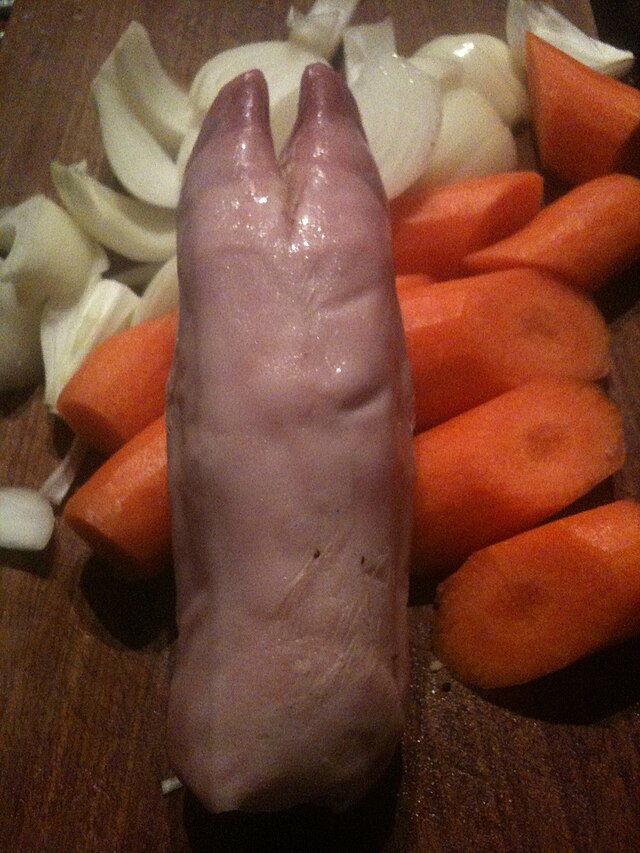Top Qs
Timeline
Chat
Perspective
Pig's trotter
Culinary term for pig's feet From Wikipedia, the free encyclopedia
Remove ads
A pig's trotter, also known as a pettitoe,[1] is the culinary term for a pig's foot. It is used as a cut of pork in various dishes around the world, and experienced a resurgence in the late 2000s.[2]

Description


Before sale, the trotters are cleaned and typically have the hairs pulled with a hot tank and beaters.[3] They are often used in cooking to make stocks, as they add thickness to gravy, although they are also served as a normal cut of meat.[3] In Puerto Rico, a tomato-based stew of pigs' trotters with chickpeas is called patitas de cerdo. Sometimes potatoes or butternut are added. British chef Marco Pierre White has long served trotters at his restaurants,[4] based on the original recipe of mentor Pierre Koffmann.[5]
Following the Great Recession, there was a boom in popularity of pigs' trotters in the United Kingdom as a revival in cheap meat recipes occurred.[2] In 2008, British supermarket Waitrose reintroduced trotters to its stores,[4] and found that they quickly became popular.[2]
In Norwegian tradition, pigs' feet are salted and boiled and served as syltelabb. This is a pre-Christmas dish because the pig was slaughtered before Christmas, and everything was used. Today syltelabb is for enthusiasts.[6]
Remove ads
Recipes and combinations


- Bean crock (les pais au fou) in Jersey, Channel Islands
- Batsoà from the Piedmont region of Italy
- Cappello da prete in Modena, Italy
- Chispalhada in Portugal: trotter with chickpeas or beans[7]
- Cotechino in Modena, Italy
- Zampone in Modena, Italy
- Körömpörkölt in Hungary
- Crubeens in Ireland
- Pied de cochon in Sainte-Menehould, France
- Tebichi in Okinawa, Japan
- Tom tin moo in Laos
- Crispy pata, Paksiw na pata, and patatim in the Philippines
- Manitas de cerdo in Spain
- Jokbal in Korea
- Patitas de cerdo en escabeche and manitas de cerdo en salsa verde o salsa roja in Mexico
- Souse in Barbados and St. Vincent and the Grenadines
- Spitzbein or Pfoten in German, known as golonka in Polish
- Syltelabb, a traditional Norwegian dish
- Inkokta grisfötter, a traditional Swedish dish similar to syltelabb
- Kha mu, literally "pigs' feet" in Thai, influenced by Chinese stewed pork
- Patitas con maní and Sarza de patitas in Peru[8][9][10]
- Peus de porc in Catalonia
Remove ads
See also
References
External links
Wikiwand - on
Seamless Wikipedia browsing. On steroids.
Remove ads
